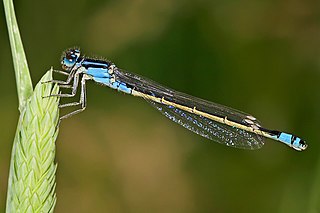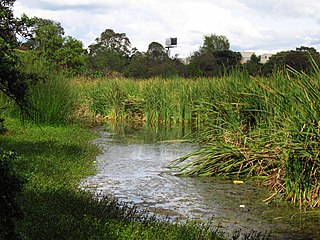
Damselflies are flying insects of the suborder Zygoptera in the order Odonata. They are similar to dragonflies but are usually smaller and have slimmer bodies. Most species fold the wings along the body when at rest, unlike dragonflies which hold the wings flat and away from the body. Damselflies have existed since the Late Jurassic, and are found on every continent except Antarctica.

Enallagma cyathigerum is a species found mainly between latitudes 40°N and 72°N; It is widely distributed in the Palearctic, and the Nearctic species Enallagma annexum was at one time considered to be synonymous with it. The species can reach a length of 32 to 35 mm. It is common in many different countries including Russia, Sweden, Norway, Finland, the United States of America, and South Korea. Damselflies are an important link between the health of the aquatic ecosystem and its response to climate change.

The blue-tailed damselfly or common bluetail is a damselfly, belonging to the family Coenagrionidae.

Coenagrionidae or are a family of damselflies, also known as pond damselfies, in the order Odonata and the suborder Zygoptera. The Zygoptera are the damselflies, which although less known than the dragonflies, are no less common. More than 1,300 species are in this family, making it the largest damselfly family. The family Coenagrionidae has six subfamilies: Agriocnemidinae, Argiinae, Coenagrioninae, Ischnurinae, Leptobasinae, and Pseudagrioninae.

Ischnura aurora, the gossamer damselfy or golden dartlet and also known as the aurora bluetail, is a species of damselfly in the family Coenagrionidae.

The flame-winged parakeet, also known as the brown-breasted parakeet, is a species of parrot in the family Psittacidae. It is endemic to forest edge and shrub at altitudes of 1,700–3,400 m (5,600–11,200 ft) above sea level on the east Andean slope in Colombia. It is threatened by habitat loss.

Ischnura is a genus of damselflies known as forktails in the family Coenagrionidae. Forktails are distributed worldwide, including various oceanic islands. The males have a forked projection at the tip of the abdomen which gives the group their common name.

Eastern forktail is a member of the damselfly family Coenagrionidae.

Chingaza National Natural Park is located in the Eastern Ranges of the Colombian Andes, northeast of Bogotá, Colombia in the departments of Cundinamarca and Meta. The elevation in the park, to the east of the Altiplano Cundiboyacense, ranges from 800 metres (2,600 ft) to 4,020 metres (13,190 ft), and the temperature ranges from 4 to 21.5 °C. The park extends over the Cundinamarca municipalities La Calera, Fómeque, Guasca and San Juanito (Meta).
La Conejera is a wetland, part of the Wetlands of Bogotá, located in the locality Suba, Bogotá, Colombia. The wetland, in the Juan Amarillo River basin on the Bogotá savanna covers an area of 58.9 hectares.

Santa María del Lago is a wetland, part of the Wetlands of Bogotá, located in the locality Engativá, Bogotá, Colombia. The wetland on the Bogotá savanna covers an area of 12 hectares, of which 4 hectares water.
Tuberculobasis williamsoni is a species of damselfly in the family Coenagrionidae first identified in Colombia and Venezuela.

The Eastern Hills are a chain of hills forming the eastern natural boundary of the Colombian capital Bogotá. They are part of the Altiplano Cundiboyacense, the high plateau of the Eastern Ranges of the Colombian Andes. The Eastern Hills are bordered by the Chingaza National Natural Park to the east, the Bogotá savanna to the west and north, and the Sumapaz Páramo to the south. The north-northeast to south-southwest trending mountain chain is 52 kilometres (32 mi) long and its width varies from 0.4 to 8 kilometres. The highest hilltops rise to 3,600 metres (11,800 ft) over the western flatlands at 2,600 metres (8,500 ft). The Torca River at the border with Chía in the north, the boquerón Chipaque to the south and the valley of the Teusacá River to the east are the hydrographic limits of the Eastern Hills.

The Suárez River, originally Saravita, is a river in the Eastern Ranges of the Colombian Andes. The river originates in Lake Fúquene on the border of Cundinamarca and Boyacá and its mouth is the confluence with the Chicamocha River, forming the Sogamoso River in Santander. It is part of the Magdalena Basin flowing towards the Caribbean Sea.
La Florida is a wetland and park known as the Parque Metropolitano La Florida. La Florida is located across the Bogotá River from Jaboque wetland in the municipality Funza, Cundinamarca, close to Cota. La Florida does not belong to the protected wetlands of Bogotá.
The Las Juntas Formation or Las Juntas Sandstone is a geological formation of the Altiplano Cundiboyacense and Tenza Valley, Eastern Ranges of the Colombian Andes. The Las Juntas Formation is found in the departments Cundinamarca, Boyacá and Casanare. The predominantly sandstone formation dates to the Early Cretaceous period; Hauterivian epoch, and has a maximum thickness of 910 metres (2,990 ft).

Ischnura rubilio, western golden dartlet, is a species of damselfly in the family Coenagrionidae. It is found in Indian subcontinent and Iran.
Sticta arbuscula is a species of foliose lichen in the family Peltigeraceae. Found in the South American Andes, it was formally described by Bibiana Moncada and Robert Lücking in 2012. The type specimen was collected in Chingaza National Natural Park at an altitude of 3,430 m (11,250 ft). The lichen is found in the Andes of Colombia and Ecuador, at elevations between 3,000 and 3,700 m, where it grows on bark of twigs and stems. It typically associates with bryophytes from the family Lejeuneaceae and the genera Plagiochila, Metzgeria, Jubula, and Omphalanthus. The specific epithet arbuscula refers to the characteristic arbuscular isidia–branched with a stalk at the base.
Sticta isidiokunthii is a species of foliose lichen in the family Peltigeraceae. Found in the South American Andes, it was formally described by Bibiana Moncada and Robert Lücking in 2012. The type specimen was collected by the first author in the Chingaza National Natural Park (Cundinamarca) at an altitude of 3,430 m (11,250 ft). The lichen occurs in the Andes of Bolivia and Colombia at elevations between 2,290 and 3,600 m. It grows on the bark of shrubs and small trees, often associated with liverworts in the genera Metzgeria and Microlejeunea, as well as lichens from the genera Erioderma, Leptogium, and Sticta. The specific epithet refers to its resemblance to Sticta kunthii and the fact that it makes isidia.













